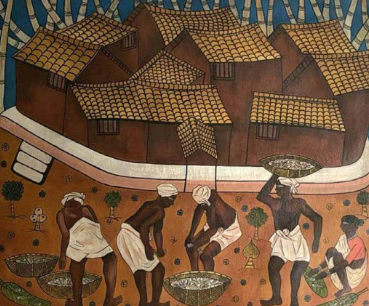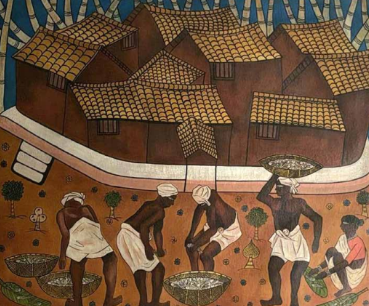Gallery Silver Scpaes
The Fish Market
The Fish Market
Couldn't load pickup availability
Artist: AA Almelkar
Medium: Oil on Canvas
Size: 42 × 50 inches (106.68 × 127 cm)
Year: 1955
Rooted in cultural authenticity and compositional finesse, this masterful artwork offers a compelling portrayal of rural life imbued with grace, dignity, and timeless resonance. At the heart of the painting lies a harmonious interweaving of human activity and architectural form, where meticulously rendered thatched-roof dwellings rise against a tranquil landscape, forming a textured backdrop to the poised gestures of laboring figures. Each element is executed with refined precision, underscoring the artist’s deep sensitivity to the rhythms and rituals of agrarian life.
The scene is animated by figures whose movements, though grounded in the exertion of daily toil, are rendered with a lyrical elegance. Their postures are sculptural yet fluid, embodying the quiet resilience and generational wisdom embedded in everyday tasks. The deliberate use of earthy tones, rich umbers, warm ochres, and muted siennas, creates a chromatic unity that enhances the sense of organic connection between the land, the people, and the structures they inhabit. Rhythmic patterns, seen in the arrangement of rooftops, textiles, and pathways, guide the viewer’s eye through the composition, establishing a visual cadence that mirrors the cyclical nature of rural existence. Subtle yet impactful textural variations lend the work tactile depth, inviting closer inspection and engagement. Through a thoughtful balance of detail and abstraction, the painting resists sentimentality, instead offering a respectful and nuanced tribute to a way of life often overlooked in contemporary discourse. The artist’s approach transcends documentary realism; rather, the work serves as an aesthetic meditation on tradition, community, and endurance. By honoring the dignity of rural labor and the quiet beauty of vernacular architecture, the painting becomes a visual archive of cultural continuity and environmental symbiosis.
This artwork stands not only as a celebration of rural heritage but also as a reflective lens through which viewers may consider broader themes of identity, belonging, and the intimate relationship between humanity and the land it cultivates. In its subtle textures, harmonious structure, and profound thematic depth, the piece affirms the enduring relevance of regional life and the quiet strength that pulses beneath its surface.


Why Choose Us
Art has always, naturally, reflected the development and exploration of different thoughts and perceptions, and our current postmodern era is no different. It is interesting to see how art has evolved visually, yet the traditional methods of composing art remain a valid means of expression.
All it takes for an artist to rise above normalcy, is inspiration, which fuels his passion to paint beautiful creations throughout his life.
The valuable expression of art is always there with us, but now this expression is yet to take an interesting diversion with our art gallery, Gallery Silver Scapes, located in Hauz Khas Enclave. Art is no longer considered just decorative but has evolved and come forth as a major form of investment yielding high rates of returns for its buyers, making it an expression commonly used.

Mrs Mayor was walked into the art world by the legendary modernist Bimal Das Gupta, one of whose biggest collections remains with Gallery Silver Scapes. In the 1980s, as head and first curator of the Habiart Gallery founded by Mrs Rekha Modi — a childhood friend — Mrs Mayor worked closely with and curated shows for renowned artists such as A Ramachandran, GR Santosh, Rameshwar Broota, Sakti Burman, MK Bardhan, Dhiraj Chaudhury, M Sivanesan, and Arup Das among others.
Besides modern masters, she also worked with young contemporaries such as Sudip Roy, Paresh Maity, Subroto Kundu, Vinod Sharma, and many more. Artworks commissioned by her are now part of prestigious collections, such as those of the India Habitat Centre, Ranbaxy, Pepsi, Hotel Lalit, Bank of America, and many more private and public collections.


